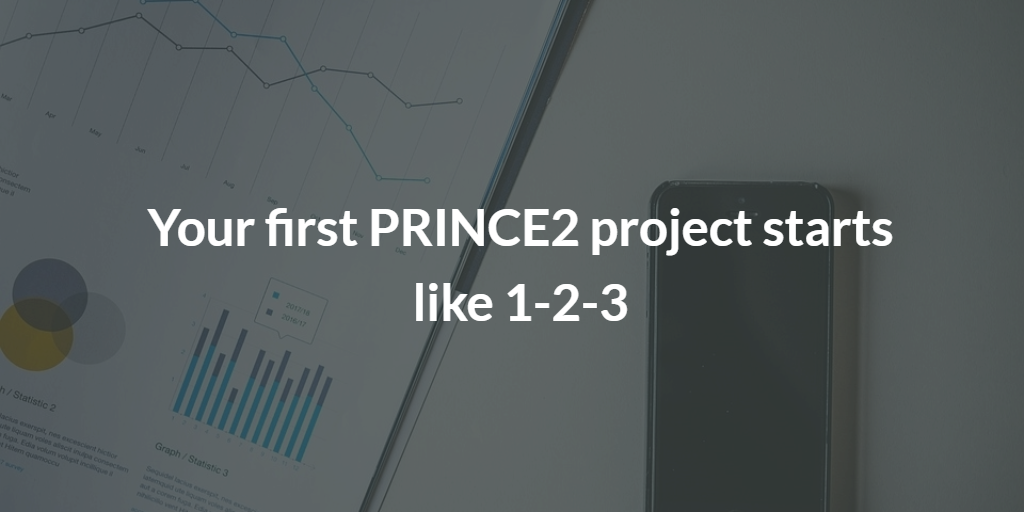Here’s how to start your first project with PRINCE2 in three easy steps
You have been to PRINCE2 training, you’ve sat the exam. Now you are back at your desk. You re-open the manual, with its 320 pages, 19 chapters and 26 documents… where do you start?
Let’s make this as simple as 1-2-3.
Write the Project Brief and get it agreed by your executive
As its name suggest, the Project Brief is a SHORT document. Make the document easy to read. The PRINCE2 book gives a suggested composition of the document, but go for readability and clarity rather than formality and detail.
The brief should include the project organisation structure. You are the project manager, and you need an executive. This is VITAL, yes, the absolutely vital minimum – without an executive you are not using PRINCE2. The Executive will assume responsibility for the project, you will be executing on his or her behalf.
The Brief should also include a definition of the Project Product – your final deliverable. It’s important to write this down, as it defines your scope. The PRINCE2 book says this is a separate document, but you can probably write it as a paragraph of your Brief.
To define your Project Product correctly, you need to understand who is your Customer or User (could be an internal or external customer). You need to discuss your deliverable with your Customer, to understand their needs. The Project Brief should include their quality expectations and acceptance criteria.
When the Project Brief is written, the Executive should validate it. Until this is done, you should not move forward.
Create a Product Breakdown Structure, and get it agreed
The Product Breakdown Structure (or PBS) is a great way to understand what you need to produce. The PBS starts with your Project Product which is your final deliverable. The PBS will show more detail – it will probably show 15 or 20 key deliverables.
The easiest way to create a PBS is with sticky-notes on a flip chart or whiteboard. If you use sticky-notes, it’s easy to reshape the PBS as ideas emerge. Ideally you work with a colleague or two, to ensure you get an all-round vision.
When it’s done, you can convert the sticky-notes version into electronic form with a diagramming tool, such as Visio or Powerpoint.
It’s important to create a PBS before you do any planning. For PRINCE2, the PBS is a first step of planning. If you are using a planning tool, such as Microsoft Project or even Excel, you should create your PBS and get it agreed BEFORE you do any work with your planning tool. Keep the PC switched off!
You need to review the first version with key people – the Project Executive, your Customer or User, and with the team leads who will produce the solution. When it’s agreed, build a high level Project Plan around the 15 or 20 deliverables in your PBS.
Create a Business Case, working with your executive
The business case provides the business justification for the Project. It explains the resources that the project will use, and balances them against the expected benefits. It’s an important document,but you need to apply the KISS rule (Keep it Simple and Short)
The problem with the business case is to decide how much detail you need. Your executive will guide you regarding the level of detail. Apply the KISS rule, and NEVER add unnecessary detail (for example, if your company doesn’t need you to express benefits in cash terms, then DONT try).
You start with a summary of your resources needs, and the expected benefits. (In some projects, that’s all that is needed).
• The resources are typically people and/or money. You need to understand the type of resources you will need. (For example, you need designers and testers, plus money to buy some equipment).
• The justification is based on benefits – get input from your executive about expected benefits. You both need to understand the type of benefits your project will generate. (For example, cost savings and reduced maintenance).
Once you have a summary, you can add more detail, but ONLY IF NECESSARY. You may need to convert resources and benefits into money terms. You may need a timeline. You may need a complex financial calculation such as NPV. But ALWAYS apply the KISS rule – don’t do work that you don’t need.
In three easy steps, we have the foundations for the PID (the Project Initiation Document). The three key pillars for the PID are the Project Brief, the Project Plan and the Business Case. Our three easy steps create those three pillars.
That’s how to convert your PRINCE2 classroom training into practice. Just take three easy steps, 1, 2, 3.
Article republished from Milestones by Jeff Ball









